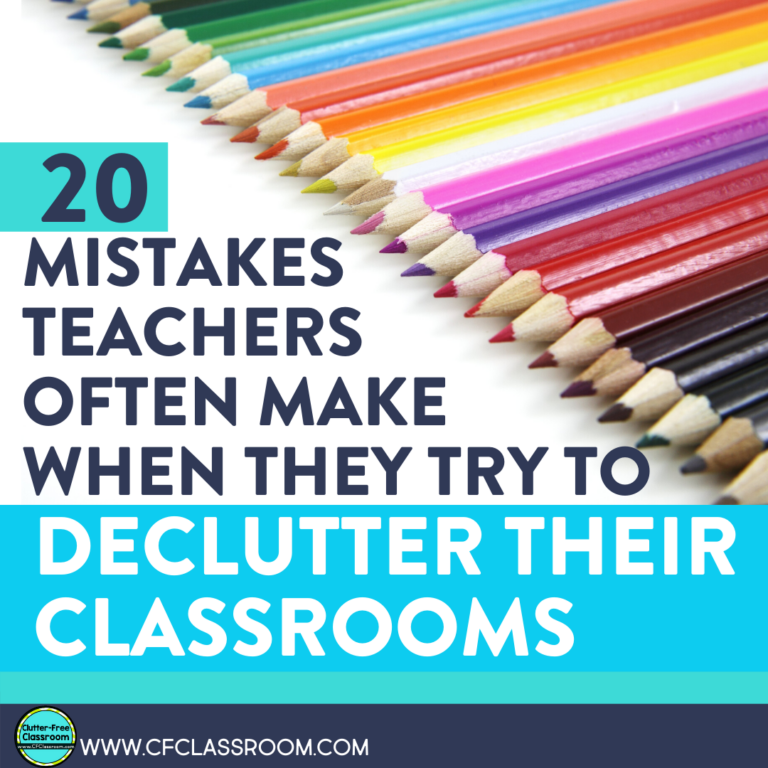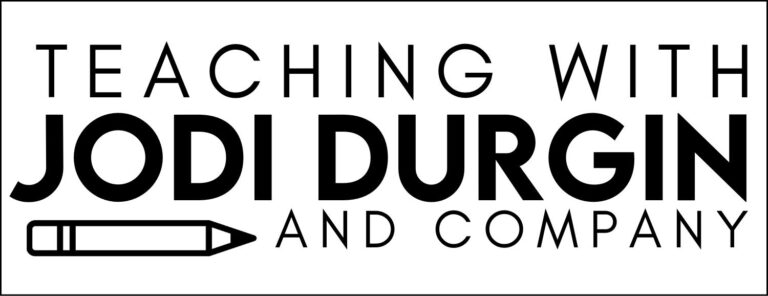Even if you’re not a teacher hoarder, there is a good chance you have too much stuff at school. If you want to declutter your classroom you may be feeling overwhelmed. Don’t be. It’s simply a matter of knowing what to keep and what to toss and having a plan. This free decluttering challenge for teachers is a great place to start!
It’s time to clear away the stuff that is not helping you or your students. No matter where you are in your teaching journey, it’s likely that you have quite a bit of decluttering to do. This surplus of things isn’t good for you and it’s definitely not good for your kids. Let’s start getting you on your path to being a much more organized teacher.
This post will help you clean out the things you’ve accumulated in your classroom. You’ll learn what to do with old teaching materials. If you are serious about decluttering your classroom this year, be sure to check out my Classroom Organization Workshop for Teachers.
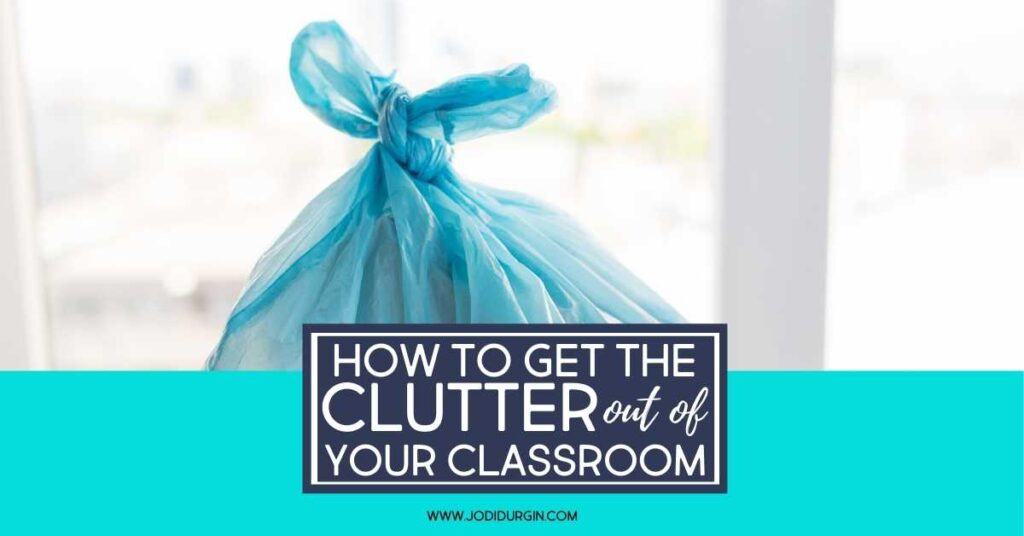
5 Reasons You Need to Declutter Your Classroom
Without even realizing the extent of it, having too many things is causing problems for you as a teacher. Chances are, an untidy classroom is also negatively impacting your life outside of school, too.
I am so passionate about removing stuff from classrooms because I’ve seen how it hinders student growth and teacher productivity. The items you possess should help achieve your professional goals and the learning goals you set for your students. Your things should not be obstacles that impede those goals.
I could easily share a lengthy list of the benefits of having an organized classroom. However, for the sake of time, I’ll simply spotlight the top problems clutter causes for teachers and students. Clutter negatively impacts your teaching, your students’ learning and your personal life. Knowing how it does will motivate you to work through the process of decluttering.
Are you already convinced you need to declutter? If so, check out this decluttering challenge for teachers!
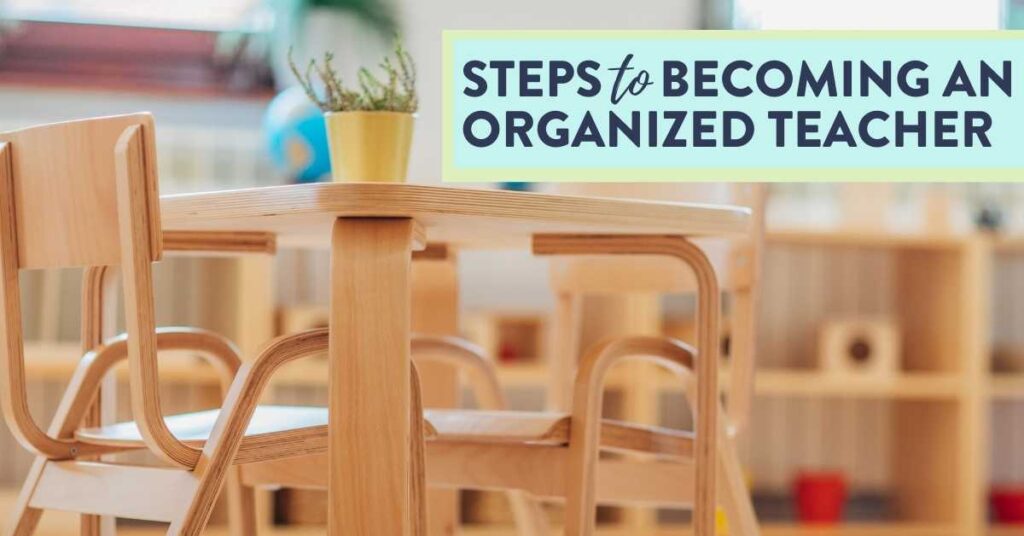
1. Too Much Stuff Costs you Time
| Are you often late for school because you are running around your home packing up your school bag, looking for the papers you’ve scattered over the weekend, or trying to locate your car keys? Do you end up staying at school later than you would like because tasks require looking for supplies and materials? It doesn’t have to be that way. Purging excess teaching materials and getting organized is the key to getting back valuable lost time. |
2. Classroom Clutter Costs you Money
| How many times have you bought a book or a teaching tool and then soon discovered you had the same item hidden in a closet or on a shelf? How many things have needed to be replaced because improper storage left them crushed, bent, folded or faded? Purging unnecessary things and organizing your classroom will spare you those expenses. |
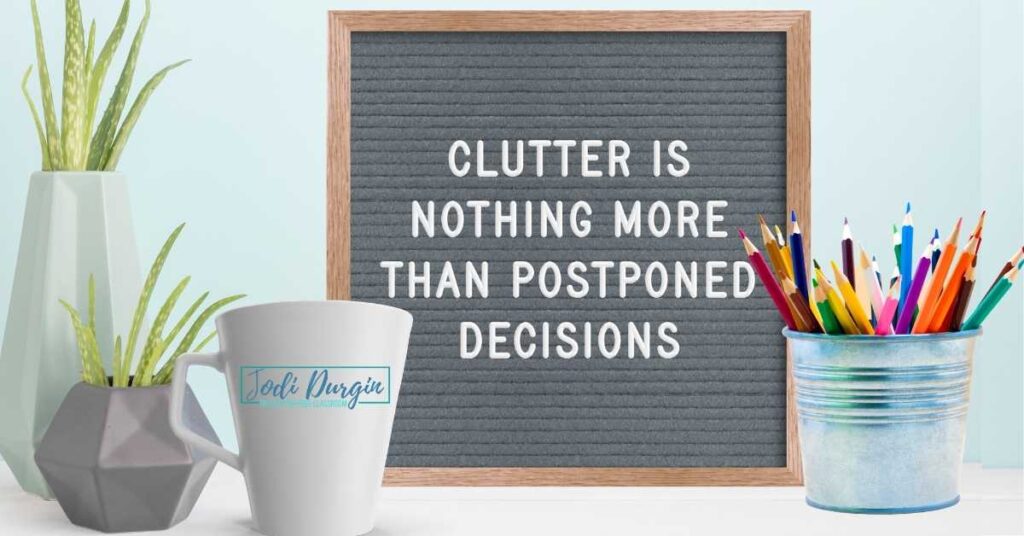
3. A Messy Classroom Causes Stress and Anxiety
| Teaching is stressful enough, but a disorganized classroom adds additional stress to your busy life. Even worse, stress wreaks havoc on your body and your mind. Taking the time to declutter your classroom and organize the space will also free up extra time for you to go for walks, hit the gym, or enjoy relaxing hobbies. Activities like these decrease your risk of teacher burnout and bring back your enjoyment of teaching. |
4. Clutter Causes Behavior Issues and Student Distraction
| Having too many things draws our attention away from what our focus should be on: planning lessons, grading, communicating with students’ families. Instead, you may be spending time moving papers from one side of your desk to the other or perhaps searching for math manipulatives in your messy storage closet. Even if you are not bothered by the amount of items or a mess in your classroom, chances are your students have a hard time learning in an environment filled with clutter. This results in decreased learning, off-task behavior, and you being a less effective teacher. When you need to look for things like your daily lesson plans, printables, and other teaching materials, students are more likely to exhibit off-task behavior. This unfortunately results in even more lost learning time. |
5. Others May View You as a Teacher Hoarder or Packrat
You may be an amazing, caring, highly effective teacher. Does your classroom reflect that? Is your space messy or disorganized? How might that impact the way administrators, colleagues and your students’ parents view you as a professional?
Clutter can affect your interpersonal relationships with the important people you work with daily. Parents and colleagues rely on you to be on time and to quickly. They expect you to fulfill your professional responsibilities without running late, missing deadlines, or failing to fulfill obligations.
A cluttered, untidy classroom is reflects poorly even if you are able to work in “organized chaos.”
The Truth About Messy Classrooms and Teacher Organization
Here’s the thing… some educators are perceived as teacher hoarders. Oftentimes, it’s not their fault. If you consider yourself to be a packrat working in a cluttered classroom, please give yourself some grace. Here’s why:
On top of that, some teachers have been teaching 20+ years and have collected so much stuff. Retiring teachers leave a surplus of things behind for the the new teacher. She then has decades of materials to deal with. It can be a blessing and a curse.
To successfully declutter your classroom, it’s important to begin by understanding why you have so much stuff. If it is because you have a scarcity mindset, you’ll need to work through those feelings.
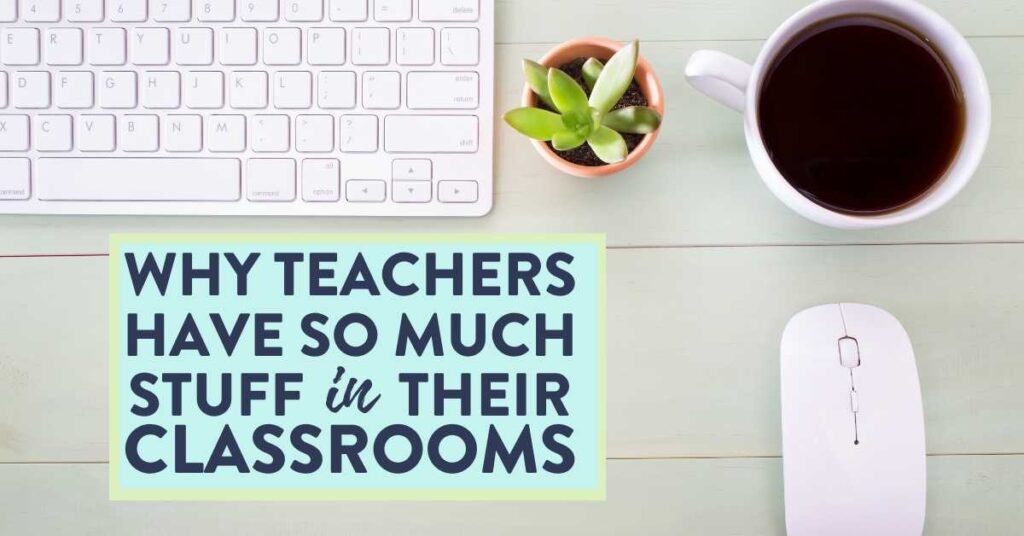
3 Reasons Teachers Have Too Much Stuff
Below are 3 reasons teachers have too much stuff.
1. Scarcity Mindset
Teachers are expected to buy too much. Aside from the basic necessities and curriculum, I personally funded everything in my classroom for years. Teachers for scarcity mindsets because expected to do so much with what little they have. If they paid money for it or think they may be able to use it one day, it becomes a permanent part of their classrooms.
2. District Mandates
Teachers are often required to house decades of outdated curriculum and old teaching materials in our classrooms even though there is a thick coating of dust on them and zero expectation to be using them.
3. It Builds Up Over Time
Some teachers have been teaching 20+ years and have collected so much stuff. Or, a retired teacher leaves everything to a new teacher, who then has decades of materials that are both a blessing and a curse.
To successfully declutter your classroom, it’s important to begin by understanding why you have so much stuff. If it is because you have a scarcity mindset, you’ll need to work through those feelings.
In our online professional development course, Classroom Organization Made Easier, I walk elementary teachers through some simple ways to overcome the mentality that all teaching materials need to be kept.
So many of them have told me that step alone made the biggest impact in getting rid of their classroom clutter. I definitely recommend you start by taking a few minutes to reflect on how your cupboards, closets, shelves and drawers became so stuffed and untidy.
What to Keep and What to Toss
Do you have the motivation to transform your classroom into a distraction-free learning environment? If so, you need to now build momentum to get the job done.
Knowing what to keep and what to toss will make the process much easier.
In the Classroom Organization workshop, we create non-negotiable rules that make it easy to clean out a classroom without overthinking what to do with each item. This step is very helpful because it personalized the process and takes into account a teacher’s individual situation.
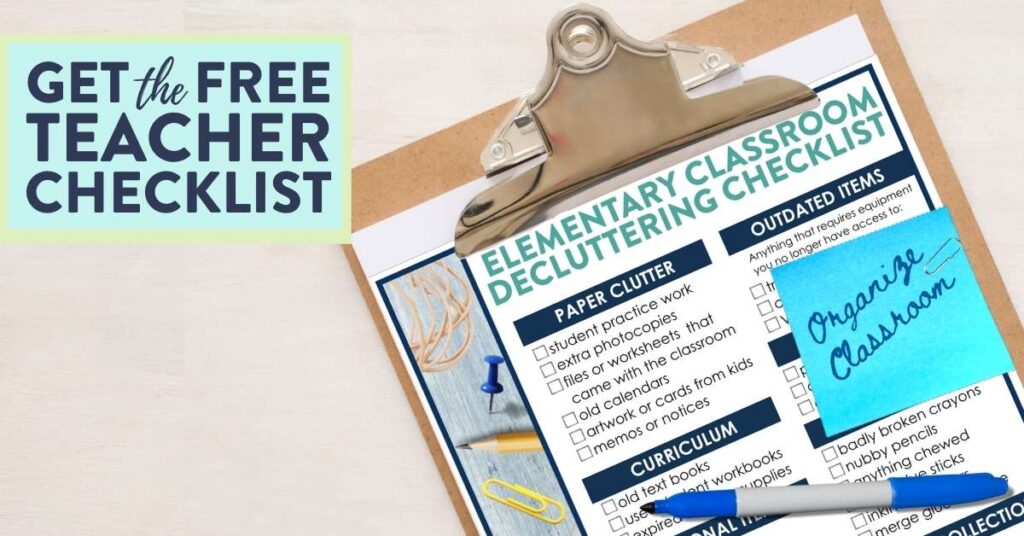
There are useless and outdated items commonly found in all elementary classrooms.
I created a free checklist for teachers of over 30 items you can pitch right away without even thinking about it.
If you’re a 1st, 2nd, 3rd, 4th or 5th grade teacher, grab the free checklist. It will help you get started on your path to a tidier classroom right away.
What to Do With the Clutter in Your Classroom
You may be wondering what to do with old teaching materials. Once you’ve decided an item needs to go, there are five ways to get rid of it.
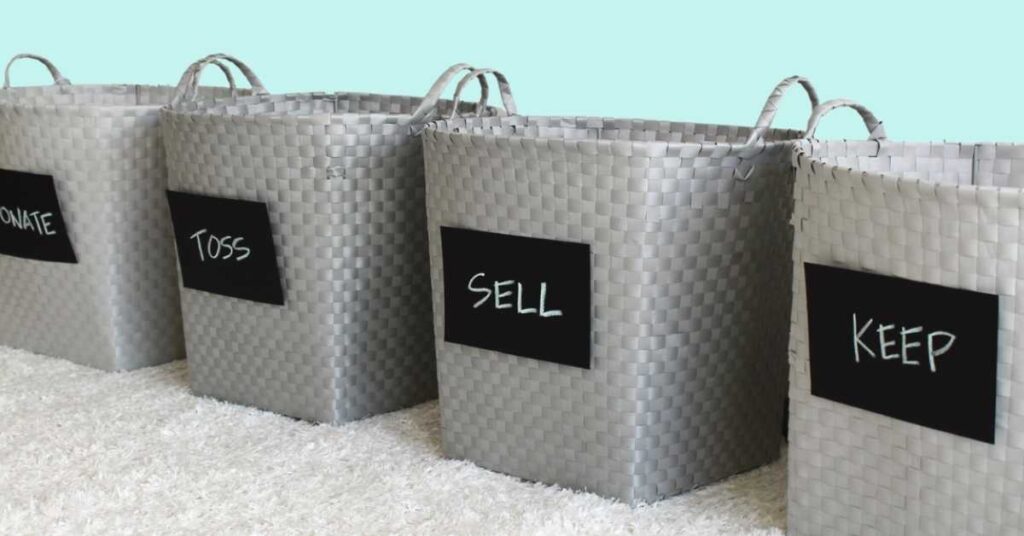
1. Trash
Broken, unusable and too out of date to use itemsc an be thrown away.
2. Recycle
Any papers or recyclable items (such as that overflowing bag of cardboard tubes from empty toilet paper and paper towel rolls) that are of no value to you or anyone else should be dropped into the recycling bin.
3. Give it Away
While you want to be careful not to burden other teachers with your junk, in some cases the saying, “one person’s trash is another person’s treasure” holds true. New teachers, student teachers, daycare centers and homeschool families can often find use for the teaching materials, manipulatives, games, and activities that are not serving you or your students.
4. Donate
If you don’t have anyone in mind to give it to, consider donating it. I am especially fond of non-profits that will come and do pickups or have drive-up drop off centers.
5. Sell It
Teachers have made a lot of money selling the things they don’t need online or via yard sales.
The last option is temping and inspirational. In Classroom Organization Made Easier, I spotlight how you can make money while organizing your classroom. I also guide teachers like you through a tried and true process declutter your classroom without feeling overwhelmed and detail all the different ways to get rid of the abundance of things in your classroom for good.
I want to share a bit of that with you here. One of the best ways to clear out your classroom and not feel guilty about getting rid of things is to host a teacher swap.
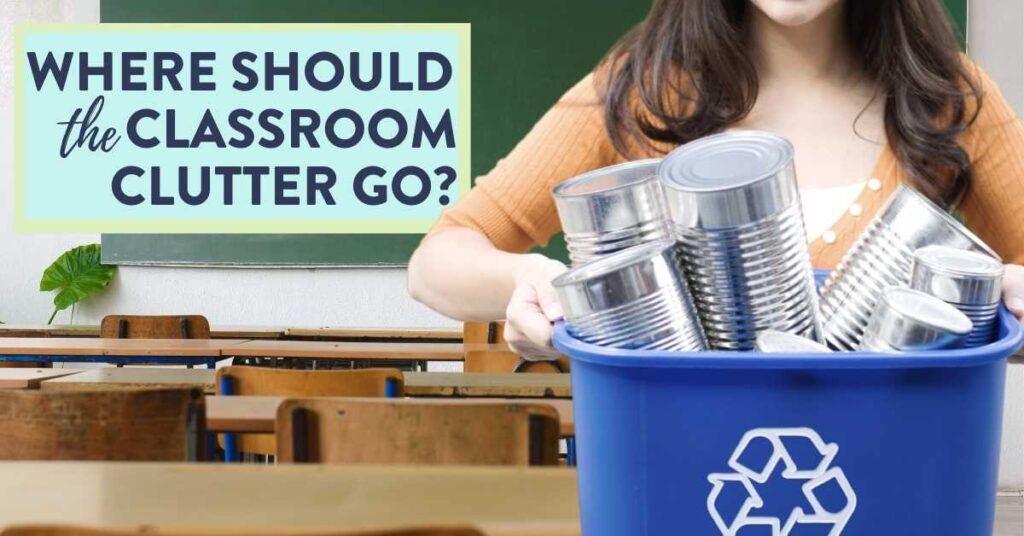
How to Plan a Teacher Swap
Below are 5 steps for planning a teacher swap in your building.
1. Consult with your administration
Make sure your administrators are on board with the idea.
2. Identify a location
We were lucky because we had a classroom available and were able to run our swap over the course of a week. This was ideal because people could drop and “shop” at their leisure. If you don’t have a room available you could get creative and designate a space behind a stage curtain, a table in the teacher’s lounge or a space in your copy room. You may also want to consider services that may end before the official school year does (library, PT, preschool) and see if they would be willing to allow you to use their space.
3. Choose a time frame.
Pick a start date and end date. Designate a specific day. Have each teacher put the unwanted materials outside their classroom door after dismissal. Teachers can stroll around looking for treasures. You could also spread it over a week if you have the space to accommodate that. You will also need to decide what time the swap will happen.
4. Create a plan for how to handle anything left over.
In our case, our custodians took care of it for us. Make sure teachers know they are responsible for their own cleanup if that is the case.
5. Spread the word about the event.
You could post a flyer, send an email, post it in the daily bulletin (if you have one), or announce it at a staff meeting. I created this flyer for you to either use or use as a model. If you choose to use it, simply fill in the date and time and spread the news to your coworkers.
10 Obstacles to Decluttering Your Classroom
Once you get past the scarcity mindset that many teachers have, there will be other obstacles that may prevent you from getting started or thwart your progress.
The best way to prevent yourself from getting stuck and giving up is to plan ahead and think about how you will overcome these challenges proactively. Reflect on the possible obstacles below and brainstorm a strategy of what you will do in response.
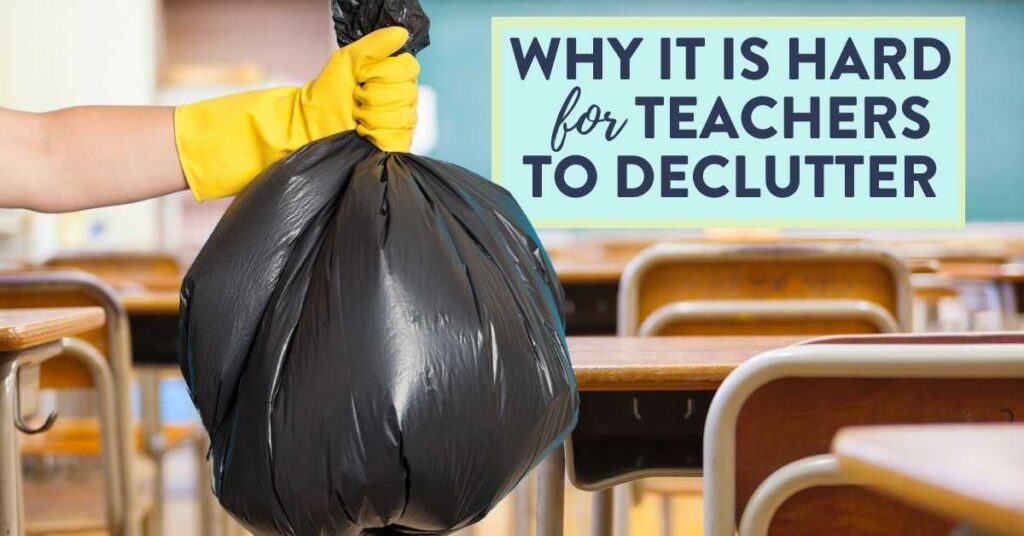
1. I am too busy and don’t have enough time to clean out my classroom.
One strategy to overcome this is to block time in your calendar. They can even be very small chunks. For example, you may say that you will work on minimizing the number of things in your classroom 15 minutes per day right after school or 30 minutes per day every Tuesday and Thursday. Look at your schedule and figure out what works best for you
2. I am exhausted and feeling burnt out as a teacher.
If you find that you are exhausted at the end of the school day or end of the school week and don’t have the energy to declutter you classroom at that time, perhaps consider working on it before school or at the beginning of the school week. Find a time and day where you feel energized and motivated to make a positive difference in your classroom.
3. Getting organized is expensive. I don’t have extra money to spend money.
There is a common misconception that decluttering and organizing your classroom has to be very expensive. You see all of those Instagram and Pinterest posts showing gorgeous organization systems with colorful bins and drawers. This is not a requirement for minimizing and organizing your classroom. There are so many free or cheap solutions.
READ | Free and Cheap Storage Solutions
4. I have a hard time letting things go.
You may feel reluctant to let things go because you paid a lot of money for them, they have sentimental value, you worry you may need it someday, or you feel wasteful getting rid of something that is in good shape. But guess what? Clutter is not serving you. It is not making your life easier. Therefore, if you are a Marie Kondo fan and want to KonMari your classroom, you can thank it for everything it has given you. If the KonMari method is not for you, just get rid of it.
5. I am overwhelmed and not sure where to start.
It’s important to sit down and create a plan before beginning. This initial time investment will prevent you from wasting even more time later on in the process. If you feel overwhelmed just thinking about a plan, then check out my Classroom Decluttering Online Workshop that will walk you step by step through everything you need to do to get a clutter-free classroom.
If you need a quick win to get the ball rolling, check out this free decluttering challenge for teachers.

6. I am not sure what to let go of.
Ask yourself these questions: Can I find this resource online? Do I absolutely love it? Have I used this item in the past year? Does it fit my vision? Am I required to keep it? Could someone else benefit from this item more than me? Is it taking up useful space? If I didn’t feel guilty, would I still keep it?
These questions will help you determine if you should keep it or not.
Also, be sure to read the section of this blog post dedicated to “what to keep and what to toss” and grab our free checklist of 30+ things to toss today to jumpstart your classroom organization journey.
7. I don’t know what to do with the stuff I am decluttering.
Evaluate each item and determine if it should be thrown away, recycled, donated, passed on to someone else, sold, or stored. It may be helpful to keep a trash can, recycling bin, and other labeled bins close by while you are going through the items.
8. I have to store old textbooks and curriculum I don’t use in my classroom.
Outdated curriculum and materials, unwanted furniture, and resources handed down from former teachers may be filling up your classroom. I recommend double checking with your school administrator to make sure you need to keep it. If so, store it in a place in your classroom that is not easily accessible.
9. The clutter in my classroom does not bother me.
Even if you do not feel that the mess or excess is negatively impacting you, it’s important to recognize that it is negatively impacting many of your students. For example, some students may find a messy or disorganized space distracting and have a difficult time focusing as a result.
10. Even if I declutter my classroom, it’s going to creep its way back.
When you finish clearing out your classroom, it’s important to establish and follow routines, employ the help of others, create an organization journal, and use one of my favorite strategies of all time: FIND IT AND FIX IT.
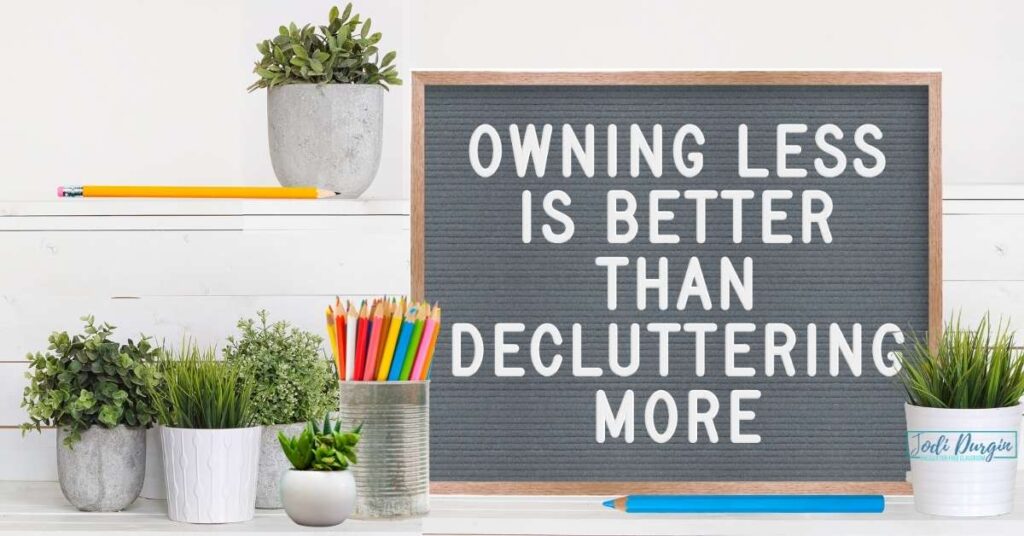
7 Mistakes Teachers Make: Don’t Do These When You Declutter Your Classroom
| Teachers sometimes thwart their classroom organization efforts without realizing it. I actually have another blog post dedicated solely to that topic. Read | The 20 Mistakes Teachers Make When They Declutter Their Classrrooms so you don’t make them when you declutter your classroom! As a preview, here are… |
7 Common Classroom Organization Mistakes
- procrastinating getting started
- trying to organize before purging the excess
- lacking the right “tools” (spoiler alert: they are cheap and easy to get)
- becoming distracted with decision making
- jumping in without a plan
- tackling the process without support
- having unrealistic expectations
The Best Way to Get Your Classroom Organized and Keep it That Way
I hope these tips and ideas have motivated you to declutter your classroom and get started on your classroom organization journey. If you haven’t already, be sure to check out this free decluttering challenge for teachers!
Being organized is a skill. It doesn’t take a lot of time or money (in fact it saves you both).
It does however take a plan to get there without feeling overwhelmed.
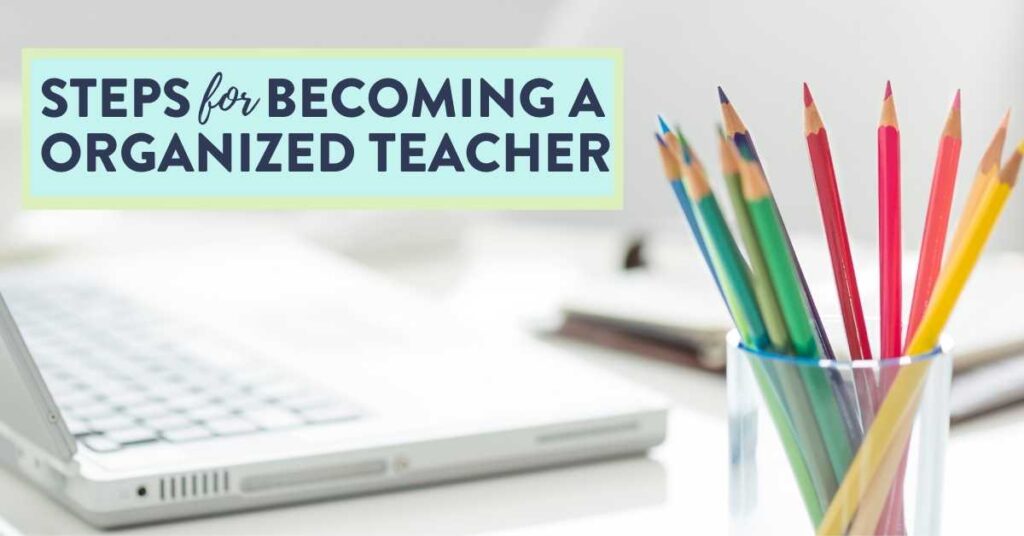
Do you want a clear, step-by-step proven process to transform your classroom into a calm, effective learning environment?
Would you like to become a much more efficient teacher?
Imagine becoming a much more efficient teacher who enjoys spending productive days with your students… without working nights or weekends.
If any of the above sounds good to you, I welcome you to check out Classroom Organization Made Easier Workshop.

